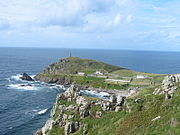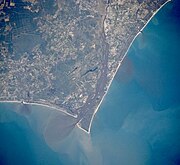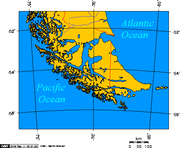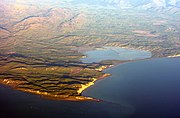Cape (geography)



In geography, a cape is a headland, peninsula or promontory extending into a body of water, usually a sea.[1] A cape usually represents a marked change in trend of the coastline,[2] often making them important landmarks in sea navigation. This also makes them prone to natural forms of erosion, mainly tidal actions, resulting in a relatively short geological lifespan.
Formation
Capes can be formed by glaciers, volcanoes, and changes in sea level.[2] Erosion plays a large role in each of these methods of formation.[3] Coastal erosion by waves and currents can create capes by wearing away softer rock and leaving behind harder rock formations. Movements of the Earth’s crust can uplift land, forming capes. For example, the Cape of Good Hope was formed by tectonic forces. Volcanic eruptions can create capes by depositing lava that solidifies into new landforms. Cape Verde, (also known as Cabo Verde) is an example of a volcanic cape.[4] Glaciers can carve out capes by eroding the landscape as they advance and retreat. Cape Cod in the United States was formed by glacial activity during the last Ice Age.[3]
Importance in navigation
Capes (and other headlands) are conspicuous visual landmarks along a coast, and sailors have relied on them for navigation since antiquity.[5][6] The Greeks and Romans considered some to be sacred capes and erected temples to the sea god nearby.
Greek peripli describe capes and other headlands a sailor will encounter along a route. The Periplus of Pseudo-Scylax, for instance, illustrates a clockwise journey around Sicily using three capes that define its triangular shape: Cape Peloro in the northeast, Cape Pachynus in the southeast, and Cape Lilybaeum in the west.[5] Sicily itself was referred to as Trinacria (or Three Capes) in antiquity.[7]
Homer's works reference a number of capes to describe journeys around the Mediterranean Sea. Menelaus, Agamemnon, and Odysseus each faced peril at the notoriously dangerous Cape Malea at the southeastern tip of the Peloponnese. Menelaus navigated via Cape Sounion on his way home from Troy, and Nestor stopped at Cape Geraestus (now Cape Mandelo) on Euboea to give offerings at the altar to Poseidon there.[6]
Cape Gelidonya (then known as Chelidonia) on the coast of Turkey served as a bearing aid for ships heading to the Egyptian port of Canopus, directly to the south. Cape Sidero on the eastern tip of Crete was a waypoint for Jason and the Argonauts returning from Libya as well as for Paul the Apostle as he traveled from Caesarea to Rome.[8]
The three great capes (Africa's Cape of Good Hope, Australia's Cape Leeuwin, and South America's Cape Horn) defined the traditional clipper route between Europe and the Far East, Australia and New Zealand.[9] They continue to be important landmarks in ocean yacht racing.
Gallery
-
 Cape Cornwall, England
Cape Cornwall, England -
 Satellite image of Cape Fear, North Carolina
Satellite image of Cape Fear, North Carolina -
 Cape MacLear, Malawi
Cape MacLear, Malawi -
 Map depicting Cape Horn at the southernmost portion of South America
Map depicting Cape Horn at the southernmost portion of South America -
 Photograph of Cabo Mayor in Santander, Spain
Photograph of Cabo Mayor in Santander, Spain -
 Photograph of Cape Campbell, New Zealand, at sunrise
Photograph of Cape Campbell, New Zealand, at sunrise - The North Cape, Finnmark, Norway
-
 Aerial view of Cape Lindesnes, Mandal, Norway
Aerial view of Cape Lindesnes, Mandal, Norway - Tipping lantern at Cape Verdens Ende, Tønsberg, Norway
See also
- Extreme points of Africa
- Extreme points of Asia
- Extreme points of Europe
- Extreme points of North America
- Extreme points of South America
Notes
- ^ Whittow 1984, p. 80.
- ^ a b Wright & Nichols 2018, p. 360.
- ^ a b "Cape". education.nationalgeographic.org. Retrieved 24 August 2024.
- ^ "Cabo Verde - Trade, Fisheries, Tourism | Britannica". www.britannica.com. 14 August 2024. Retrieved 24 August 2024.
- ^ a b Kowalski, Claramunt & Zucker 2007, p. 52.
- ^ a b Davis 2001, pp. 117–120.
- ^ Davis 2001, p. 203.
- ^ Davis 2001, pp. 122–123.
- ^ Holm 1974.
References
- Davis, Danny Lee (May 2001). Navigation in the Ancient Eastern Mediterranean (PDF) (MA thesis). Texas A&M University. Retrieved 28 July 2024.
- Holm, Don (1974). The Circumnavigators: Small Boat Voyagers of Modern Times. Englewood Cliffs, N.J: Prentice Hall. ISBN 0-13-134452-8.
- Kowalski, Jean-Marie; Claramunt, Christophe; Zucker, Arnaud (September 2007). "Thalassographeïn: Representing Maritime Spaces in Ancient Greece". In Winter, Stephan; Duckham, Matt; Kulik, Lars; Kuipers, Ben (eds.). Spatial Information Theory. 8th International Conference, COSIT 2007. Melbourne: Springer. ISBN 978-3-540-74788-8.
- Whittow, J. B. (1984). The Penguin Dictionary of Physical Geography. London New York Victoria: Puffin. ISBN 0-14-051094-X.
- Wright, Lynn Donelson; Nichols, C. Reid (15 June 2018). Tomorrow's Coasts: Complex and Impermanent. Cham: Springer. ISBN 978-3-319-75453-6.
External links
 Media related to Capes (geography) at Wikimedia Commons
Media related to Capes (geography) at Wikimedia Commons
- v
- t
- e
- Anchialine pool
- Archipelago
- Atoll
- Avulsion
- Ayre
- Barrier island
- Bay
- Bight
- Bodden
- Brackish marsh
- Cape
- Channel
- Cliff
- Coast
- Coastal plain
- Coastal waterfall
- Continental margin
- Continental shelf
- Coral reef
- Cove
- Dune
- Estuary
- Firth
- Fjard
- Fjord
- Freshwater marsh
- Fundus
- Gat
- Geo
- Gulf
- Gut
- Hapua
- Headland
- Inlet
- Intertidal wetland
- Island
- Islet
- Isthmus
- Lagoon
- Machair
- Mudflat
- Natural arch
- Peninsula
- Reef
- Ria
- Salt marsh
- Shoal
- Shore
- Skerry
- Sound
- Spit
- Stack
- Strait
- Strand plain
- Submarine canyon
- Tidal island
- Tidal marsh
- Tide pool
- Tied island
- Tombolo
- Waituna
- Windwatt


- Blowhole
- Cliffed coast
- Coastal biogeomorphology
- Coastal erosion
- Concordant coastline
- Current
- Cuspate foreland
- Discordant coastline
- Emergent coastline
- Feeder bluff
- Fetch
- Flat coast
- Graded shoreline
- Ingression coast
- Large-scale coastal behaviour
- Longshore drift
- Marine regression
- Marine transgression
- Raised shoreline
- Rip current
- Rocky shore
- Sea cave
- Sea foam
- Shoal (Peresyp)
- Steep coast
- Submergent coastline
- Surf break
- Surf zone
- Surge channel
- Swash
- Undertow
- Volcanic arc
- Wave-cut platform
- Wave shoaling
- Wind wave
- Accretion
- Coastal management
- Integrated coastal zone management
- Submersion
 Category
Category
 | This geography-related article is a stub. You can help Wikipedia by expanding it. |
- v
- t
- e






















